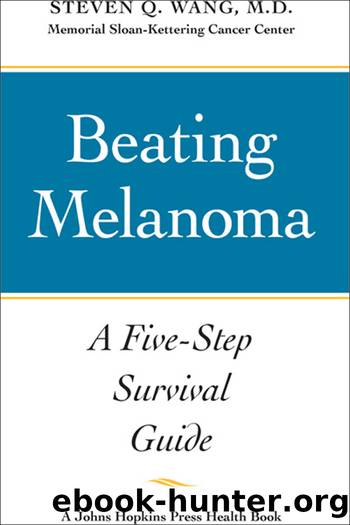Beating Melanoma by Steven Q. Wang

Author:Steven Q. Wang
Language: eng
Format: epub
Publisher: Johns Hopkins University Press
Published: 2011-09-15T00:00:00+00:00
Step 5. Understand Survival Rate and Prognosis
Prognosis means the probable outcome of a disease. This prediction can be measured in terms of cure rate, remission rate, recurrence rate, or survival rate. Although all of these measurements are valuable to researchers and to clinicians for monitoring the progress of treatments, I will focus on only the overall survival rate. Survival rate depends on the AJCC stage of the disease, patientsâ response to the treatments, patientsâ general health, and other factors.
Before I discuss the survival rates for different stages of melanoma, I want to highlight the following points. First, the survival data presented below come from research studies. These are the same survival data quoted in many medical textbooks. The data were compiled from studies of large populations of patients with known stages of melanoma and who had had long-term follow-up. These data represent the best estimate, based on the historical data, of patient survival rates.
There are many factors to keep in mind when looking at these survival data. First, these are predictions of the survival outcomes of groups of patients with similar stages of disease. This does not mean that all patients in a particular group will have the same outcome. The data presented are the average survival rates for groups of similar patients. There will always be exceptions in any statistical model. I have taken care of patients with very advanced stages of disease who have defied the statistical prediction and are still doing very well decades after their initial diagnosis and treatment.
Second, the survival data were generated by melanoma studies done several years ago, when our understanding and treatment of the disease was not as advanced as it is today. Modern science and clinical research are advancing at a breathtaking pace. New treatment regimens have been, and are continually being, developed to combat this cancer. Although the survival rate for advanced stages of melanoma can be disheartening, it is entirely possible for modern medicine to alter the course of even late-stage disease.
Third, the validity of any prediction model depends on the size of the patient samples. A good question to ask about any research study is, How many patients were in the study? If the prediction is based on a small number of patients, it may be less accurate than a model generated from a large sample of patients. The survival data presented below are based on 38,918 patients, a large sample; but for stage III and stage IV disease, the survival data are based on only 3,307 and 7,972 patients, respectively.
Download
This site does not store any files on its server. We only index and link to content provided by other sites. Please contact the content providers to delete copyright contents if any and email us, we'll remove relevant links or contents immediately.
Spare by Prince Harry The Duke of Sussex(5056)
Machine Learning at Scale with H2O by Gregory Keys | David Whiting(4127)
Fairy Tale by Stephen King(3199)
Will by Will Smith(2773)
Hooked: A Dark, Contemporary Romance (Never After Series) by Emily McIntire(2484)
The Bullet Journal Method by Ryder Carroll(2462)
Rationality by Steven Pinker(2276)
It Starts With Us (It Ends with Us #2) by Colleen Hoover(2178)
Can't Hurt Me: Master Your Mind and Defy the Odds - Clean Edition by David Goggins(2171)
Friends, Lovers, and the Big Terrible Thing by Matthew Perry(2102)
The Becoming by Nora Roberts(2068)
Love on the Brain by Ali Hazelwood(1942)
The Strength In Our Scars by Bianca Sparacino(1768)
HBR's 10 Must Reads 2022 by Harvard Business Review(1765)
A Short History of War by Jeremy Black(1745)
Leviathan Falls (The Expanse Book 9) by James S. A. Corey(1635)
515945210 by Unknown(1585)
A Game of Thrones (The Illustrated Edition) by George R. R. Martin(1566)
Bewilderment by Richard Powers(1523)
